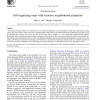Free Online Productivity Tools
i2Speak
i2Symbol
i2OCR
iTex2Img
iWeb2Print
iWeb2Shot
i2Type
iPdf2Split
iPdf2Merge
i2Bopomofo
i2Arabic
i2Style
i2Image
i2PDF
iLatex2Rtf
Sci2ools
NN
2002
Springer
2002
Springer
Self-organizing maps with recursive neighborhood adaptation
Self-organizing maps (SOMs) are widely used in several fields of application, from neurobiology to multivariate data analysis. In that context, this paper presents variants of the classic SOM algorithm. With respect to the traditional SOM, the modifications regard the core of the algorithm, (the learning rule), but do not alter the two main tasks it performs, i.e. vector quantization combined with topology preservation. After an intuitive justification based on geometrical considerations, three new rules are defined in addition to the original one. They develop interesting properties such as recursive neighborhood adaptation and non-radial neighborhood adaptation. In order to assess the relative performances and speeds of convergence, the four rules are used to train several maps and the results are compared according to several error measures (quantization error and topology preservation criterions). q 2002 Elsevier Science Ltd. All rights reserved.
Classic Som Algorithm | Neighborhood Adaptation | Neural Networks | NN 2002 | Topology Preservation |
| Added | 22 Dec 2010 |
| Updated | 22 Dec 2010 |
| Type | Journal |
| Year | 2002 |
| Where | NN |
| Authors | John Aldo Lee, Michel Verleysen |
Comments (0)

